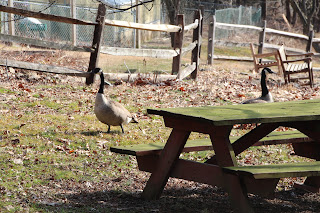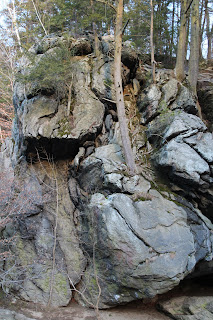An American beech (Fagus grandifolia) that looks like it's bearing the weight of the world.
I wonder why those bulges develop?
I led the the second installment of my "one trail walked 12 times " over the course of a year program a week ago on Sunday afternoon, February 19. The day was cold (like it was during the January jaunt), but unlike January it was sunny and snowless.I wonder why those bulges develop?
A pine sapling barked by a buck rubbing its antlers
Emerging from the woods into the meadows (which are bisected by a church's driveway)
Praying mantis (Mantis spp.) egg case on a blackberry cane (Rubus spp.). In looking up the scientific binomial of the the mantis, I learned that there are two mantid species living in the northern and eastern United States, both of which were introduced, one from Europe and one from China (the Chinese mantid is in a different genus! Native mantids are only found in the southern states.
Shriveled fruit of horse nettle or ground cherry (Solanum carolinense). When they're ripe, you can make a jelly from the fruits of this native weed in the tomato family (Solanaceae).
You can tell it's been a mild winter: multiflora rose (Rosa multiflora) hips are still to be found in February Persistent seed heads of a pioneer tuliptree (Liriodendron tulipifera)
Navigating the damp lower end of the meadows before entering the woods
Hikers on the footbridge spanning the ravine
Pointing out skunkcabbage emerging from the winter's duff in the spring run
Skunkcabbage (Symplocarpus foetidus)
Mossy rocks in the spring run
One of the trail's eponymous springs
Rent asunder by lightning
Assorted vertebrae from a hapless white-tailed deer (Odocoileus virginiana)
The final leg of the trail leads through an allee of white pines planted in the 1920s
I wish that I could devote a bit more time to composing my images, but leading the walk, trying to find and point out interesting natural history features, and taking pictures make photography challenging.










































